- Scientific name: Scirpus ancistrochaetus Schuyler
- Species of Greatest Conservation Need (MA State Wildlife Action Plan)
- Endangered (MA Endangered Species Act)
- Endangered (US Endangered Species Act)
Description
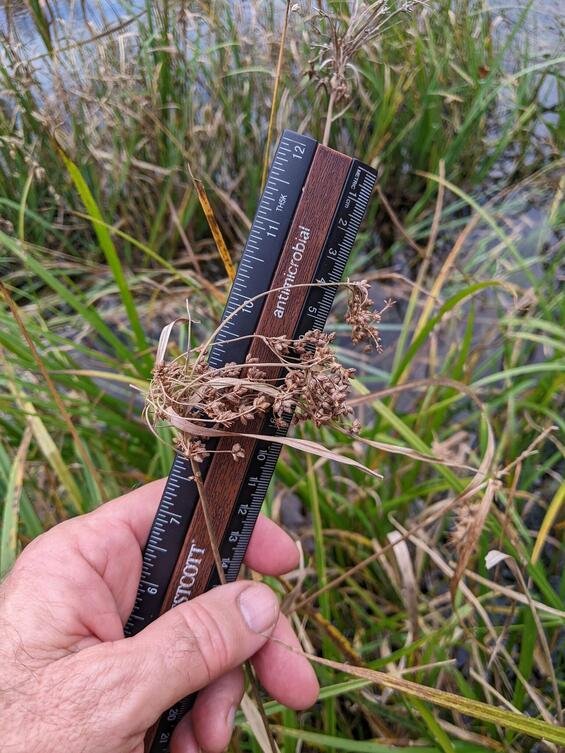
Northeastern bulrush fruiting head
Northeastern bulrush is a leafy tufted perennial sedge (family Cyperaceae), known throughout its range from a variety of wetland types with fluctuating water levels. This species is globally rare and is listed under the federal Endangered Species Act as endangered.
Growing sometimes over a meter in height 1 m (~3.3 ft), the reproductive culms have five to nine leaves, 7-13 mm (0.28-0.5 in) wide. The basal sheaths are green to brown. The inflorescence has drooping rays bearing sessile clusters of 2 to 18 spikelets. Bulrushes generally have oval to egg-shaped spikelets, bearing numerous flowers subtended by scales. In northeastern bulrush, the ovary has three styles, and the fruit (an achene) has six bristles at the base; these are straight and stout, with thick retrorse (downward pointing) barbs that cover 60% to 90% of the length. The bristles are largely concealed by the scales.
An expert is likely needed to positively identify plants. Reproductive culms will need to be present, a technical key should be consulted, and a lens with a minimum of 10X magnification. In appropriate habitat, leafy-stemmed bulrushes should be examined for the following characteristics:
- Most rays drooping and bearing sessile spikelets
- Six straight bristles (not contorted or woolly), mostly concealed by the scales
- Bristles that are stout with relatively wide, retrorse barbs over more than 60% of the length
Northeastern bulrush frequently co-occurs with wool-grass (Scirpus cyperinus) which can easily be differentiated by its long woolly bristles conspicuously exceeding the scales. A few other bulrush species, however, have concealed (non-woolly) bristles. In contrast to northeastern bulrush, wood bulrush (S. expansus) and barber-poll bulrush (S. microcarpus) have basal sheaths that are reddish; mosquito bulrush (S. hattorianus) and dark-green bulrush (S. atrovirens) have bristles with barbs that cover less than 60% of their length; and Georgia’s bulrush (S. georgianus) has up to three bristles, which are typically smooth or with barbs only at the very top. Further, these five species generally have more spreading to upright rays and bloom at earlier times of the year.
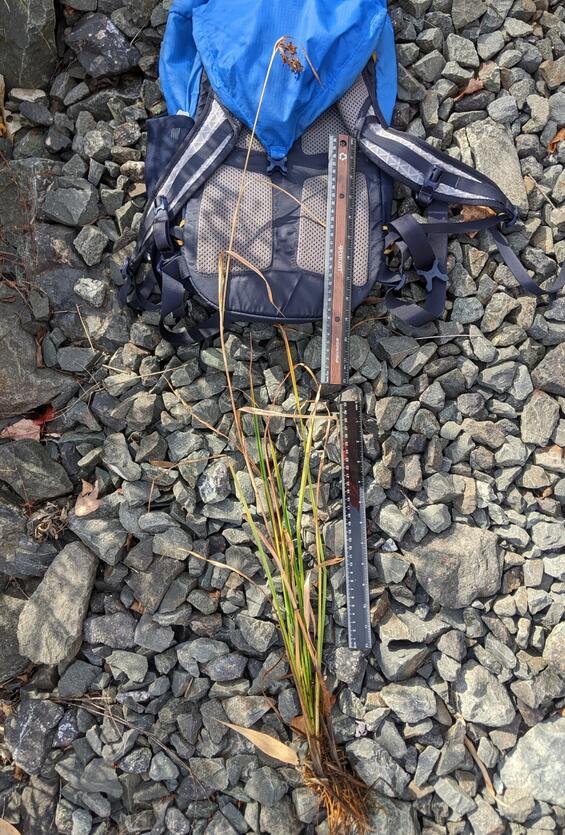
Full length specimen with two 12 inch rulers showing overall height of a little over 3 feet.
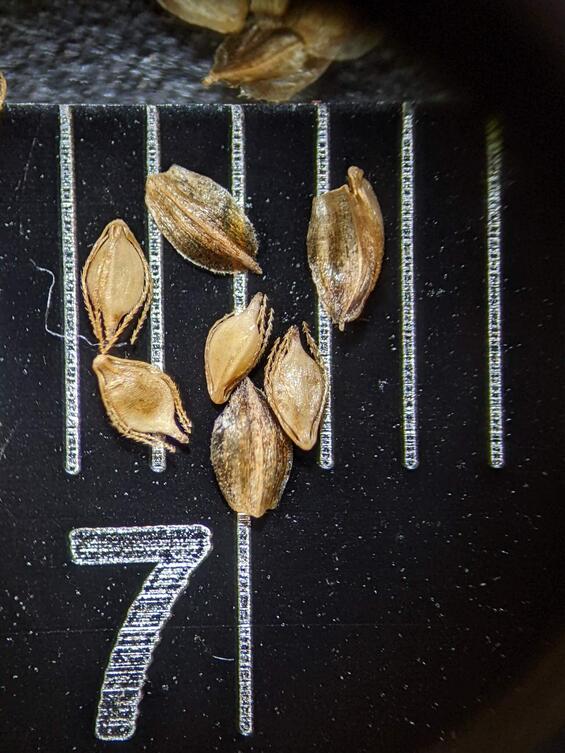
Achenes, bristles and pistillate scales
Life cycle and behavior
This is an herbaceous perennial species.
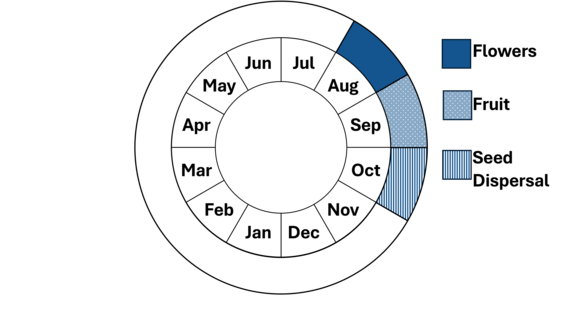
Population status
Northeastern bulrush occurs in six sites in Massachusetts, four in Franklin County and two in Hampshire County. All populations are relatively small, some only a few plants. The largest and most consistent population is threatened by an invasive shrub.
Northeastern bulrush is listed under the Massachusetts Endangered Species Act as Endangered. All listed species are protected from killing, collecting, possessing, or sale and from activities that would destroy habitat and thus directly or indirectly cause mortality or disrupt critical behaviors.
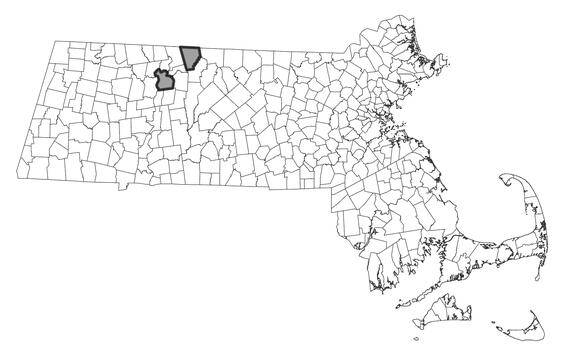
Distribution in Massachusetts
1999-2024
Based on records in the Natural Heritage Database
Distribution and abundance
Northeastern bulrush is known from most states from Vermont and New Hampshire south to Virginia. The northeastern bulrush has populations in eight states: New Hampshire, Vermont, Massachusetts, New York, Pennsylvania, Maryland, Virginia, and West Virginia. Pennsylvania has the most populations with another cluster in southern Vermont and western New Hampshire. The New England populations are more genetically depauperate and isolated from the main southern populations. As of 2019 there were 148 extant populations with 9 historical and extirpated populations (USFWS 2019). It is a ranked as globally vulnerable G3 by NatureServe.
Habitat
Throughout its range this species is known from a variety of wetland habitat types but common attributes include organic soils, fluctuating water levels, full sun, and mesotrophic to oligotrophic water chemistry. Though northeastern bulrush can occupy well-inundated wetlands, reproductive plants are typically observed at sites with saturated soils or shallow water. In Massachusetts, one population occupies a kettlehole-type depression with a floating boggy mat, and another occupies an emergent marsh on the edge of an impounded pond. Associated species include rice cut-grass (Leersia oryzoides), wool-grass, manna-grasses (Glyceria spp.), soft-stem bulrush (Schoenoplectus tabernaemontani), sweet gale (Myrica gale), leatherleaf (Chamaedaphne calyculata), buttonbush (Cephalanthus occidentalis), and sphagnum mosses (Sphagnum spp.). Northeastern bulrush is more common in Vermont; the nearest populations occupy the shallow water portions of beaver flowages and seasonally inundated perched hemlock swamps. At beaver flowage sites, populations become most robust within a few years following beaver abandonment, when water levels draw down and expose open soil. As succession proceeds, and competition from robust marsh species increases, northeastern bulrush populations decline and may disappear; the seed bank can persist, however, and following another cycle of flooding and drawdown, plants can re-appear. The populations at perched hemlock swamps are typically very small. They occupy the outer edges of the swamp, in areas with lower competition, and are best observed in low water years.
Healthy habitats are vital for supporting native wildlife and plants. Explore habitats and learn about conservation and restoration in Massachusetts.
Threats
Northeastern bulrush requires fluctuating water levels, so any activity that may alter the hydrologic regime could pose a threat. It does not compete well with dense vegetation and is expected to be particularly vulnerable to invasions of exotic wetland plants such as common reed (Phragmites australis) and purple loosestrife (Lythrum salicaria).
Conservation
More survey work is needed as several populations have recently been discovered which means that there are likely more out there to be discovered. Sites should be monitored closely for invasions and management actions should be implemented immediately if exotic invasive species are observed in the habitat. Access to the habitat by off-highway vehicles should be prohibited. All population management actions within state-listed species habitat are subject to review under the Massachusetts Endangered Species Act and should be planned in consultation with MassWildlife’s Natural Heritage Endangered Species Program.
References
Cullina M, Connolly B, Sorrie B, Somers P (2011) The vascular plants of Massachusetts: a county checklist, 1st revision. Massachusetts Natural Heritage & Endangered Species Massachusetts Division of Fisheries and Wildlife, Westborough, MA
Gleason, Henry A., and Arthur Cronquist. Manual of Vascular Plants of northeastern United States and Adjacent Canada, Second Edition. Bronx, NY: The New York Botanical Garden, 1991.
Haines A (2011) New England Wild Flower Society’s Flora Novae Angliae: a manual for the identification of native and naturalized higher vascular plants of New England. Yale University Press. 1008 pp.
Lentz, K.A. 1998. Effects of intraspecific competition and nutrient supply on the endangered northeastern bulrush, Scirpus ancistrochaetus Schuyler (Cyperaceae). The American Midland Naturalist 142:47−54.
Lentz, K.A., and W.A. Dunson. 1999. Distinguishing characteristics of temporary pond habitat of endangered northeastern bulrush, Scirpus ancistrochaetus. Wetlands 19:162−167.
Lentz, K.A., and W.A. Dunson. 1998. Water level affects growth of the endangered northeastern bulrush, Scirpus ancistrochaetus Schuyler. Aquatic Botany 60:213−219.
NatureServe. 2025. NatureServe Network Biodiversity Location Data accessed through NatureServe Explorer [web application]. NatureServe, Arlington, Virginia. Available https://explorer.natureserve.org/. Accessed: 3/31/2025
U.S. Fish and Wildlife Service. 1993. Northeastern bulrush (Scirpus ancistrochaetus) recovery plan. Hadley, Massachusetts.
U.S. Fish and Wildlife Service. 2008. Northeastern bulrush (Scirpus ancistrochaetus) 5-Year Review: Summary and Evaluation. Pennsylvania Field Office, State College, PA.
U.S. Fish and Wildlife Service. 2019. Species Status Assessment Report for the northeastern bulrush (Scirpus ancistrochaetus). Version 4. August 2019. Hadley, Massachusetts.
Contact
| Date published: | May 9, 2025 |
|---|